For Culture Night 2024, Artist-in-Residence Aideen Barry invited acclaimed multidisciplinary artist Bassam Issa Al-Sabah to pen an essay exploring his unique body of work...
I'm a visual artist working with digital animation, painting, sculpture and textiles.
World building is a huge part of my practice, as I often build installations that interrogate the intersection of fantasy and trauma, employing speculative worlds as a lens through which to explore the mechanisms of memory and identity formation.
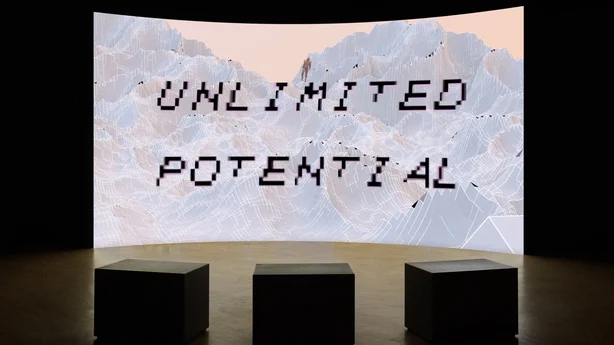
De La Warr Pavilion, Bexhill-on-Sea (Pic: Rob Harris)
Frequently drawing on the visual lexicon of video games, anime, and popular culture, I construct alternative realities that function as both a means of escape and critical commentary. These Surrealistic spaces are often juxtaposed with stark depictions of violence and destruction, their landscapes and fragmented narratives mirroring the dissonant nature of recollection and the complex processes of self-reconstruction. At the core of my practice is an investigation into how digital culture and virtual environments mediate experiences of trauma, displacement, and loss.
These constructed worlds provide a framework for reimagining personal and collective histories, where the fantastical serves not only as a refuge but as a site of confrontation.
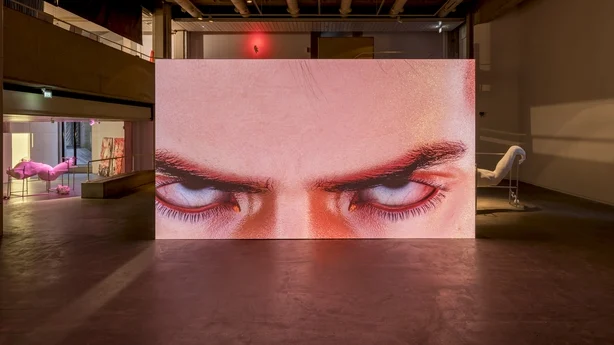
Installation view, The Douglas Hyde Gallery of Contemporary Art, Dublin.
Image courtesy The Douglas Hyde and the artist. (Pic: Louis Haugh)
In these imagined environments, I employ archetypal figures—heroic warriors, mythical creatures, and symbols of conflict—to probe the ways in which violence is mythologized and perpetuated through visual culture. Drawing on the aesthetics of role-playing games, and fantasy epics I seek to deconstruct the heroic narrative and expose its undercurrents of destruction, fragmentation, and transformation. The characters in my work are not merely passive victims or victorious heroes; rather, they occupy liminal spaces, embodying the complex interplay between power and vulnerability. Through this layered approach, I challenge viewers to reconsider the role of violence in storytelling and its pervasive influence on our understanding of identity, gender, and belonging. By reimagining these archetypes in contexts of both utopian and dystopian world-building, I aim to reveal how fantasies of control and domination shape both personal and collective histories.
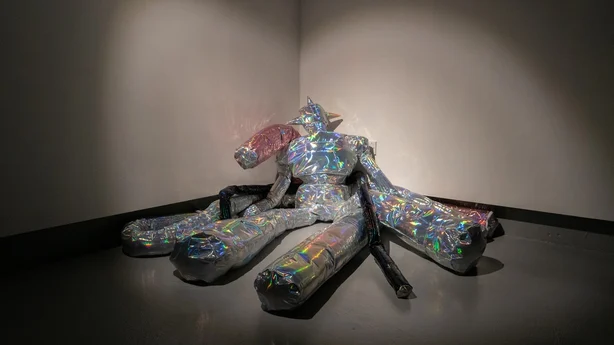
Tulca 2018 (Pic: Jonathan Sammon)
My work oftens features mutable protagonists, intertwining elements of fantasy, erotica, and body horror to critique and deconstruct the exaggerated architypes typically portrayed by digital avatars. It questions the conventional ideals associated with limitless progress and transformation, blurring the lines between external realities and internal experiences. I explore the fluidity of identity, detaching the self from superficial representations and allowing emotions to manifest in vivid, technicolour expressions.
In my earlier work I delve into how 1980s animated superheroes, specifically UFO Robo Grendizer/Goldorak, have shaped my personal and cultural identity. Growing up amidst political and social turmoil in the Middle East, these characters were more than just entertainment—they were a form of escape from the harsh realities around me.
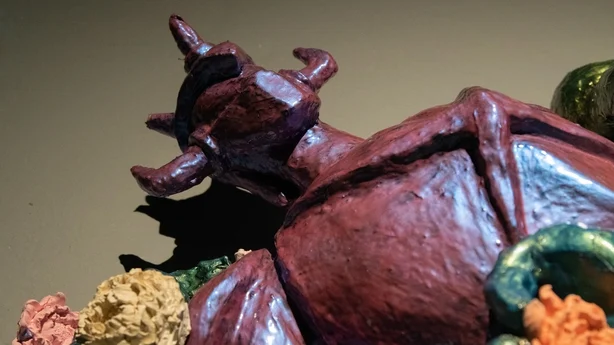
Tulca 2018 (Pic: Jonathan Sammon)
UFO Robo Grendizer, a Japanese superhero mech anime with its epic battles and futuristic technology, was incredibly popular in the region during my childhood. For me, these animated figures offered a fantasy world where heroism and power overshadowed the violence and instability of everyday life. In the work I reimagined these superheroes in various forms - sculptures of Grendizer in deflated, almost lifeless states crafted to look like deflated plastic or unfired clay, represent the collapse of the heroic ideal. Once a potent symbol of strength and resistance, Grendizer now appears as a hollow relic of past fantasies. This transformation reflects my own shift from seeing these heroes as symbols of power to viewing them as reminders of lost ideals. By integrating figures into my work, I’m not just revisiting my own experiences but also commenting on the way these superheroes have evolved—from symbols of hope to markers of disillusionment."
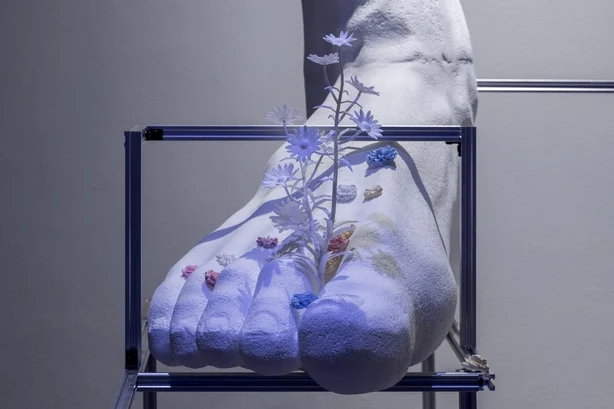
I recently worked on a major exhibition entitled Uncensored Lilac, with Jennifer Mehigan. At its core is a 30-minute film depicting a group of goddesses and their familiars in a world ravaged by rising temperatures. Borrowing from the monologuing vernacular of rape-revenge films, the film examines Ireland's colonial history while engaging in a broader conversation about historical erasure and oversimplification.
Watch: I WILL STAND IN THE LIGHT, BUT NOT THIS LIGHT, Bassam Issa Al-Sabah in collaboration with Jennifer Mehigan
The character’s communication is fractured, and they remain isolated, despite sharing the same land. As the climate crisis escalates, their monologues—fragmented, introspective, and laced with desires—expose deep frustrations and fantasies for their consumer-driven lives. set against the backdrop of escalating chaos they refuse to unite, each clinging to a commercialized, apathetic worldview. emphasizing the intersection of global warming and personal rage.
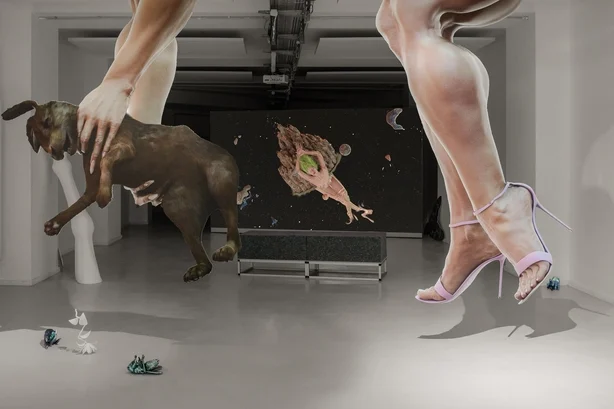
Tulca 2018 (Pic: Jonathan Sammon)
The goddesses, hyper-feminized avatars of power, exist in a world where "hotness" becomes power, reflecting the exhibition's critique of consumerism, apathy, and the commodification of femininity. This embodiment of desire and rage is mirrored in the oppressive climate that both distorts their relationships and fuels their latent hostilities.
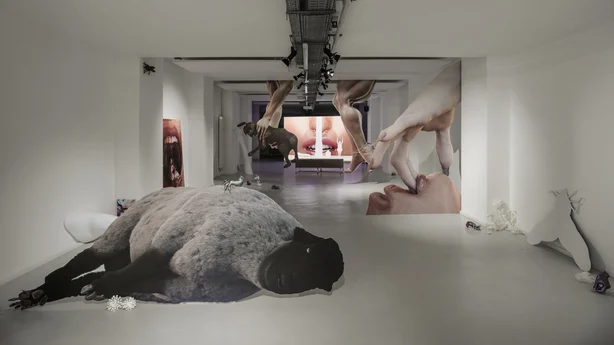
Tulca 2018 (Pic: Jonathan Sammon)
Find
Disclaimer: The copyright of this article belongs to the original author. Reposting this article is solely for the purpose of information dissemination and does not constitute any investment advice. If there is any infringement, please contact us immediately. We will make corrections or deletions as necessary. Thank you.






